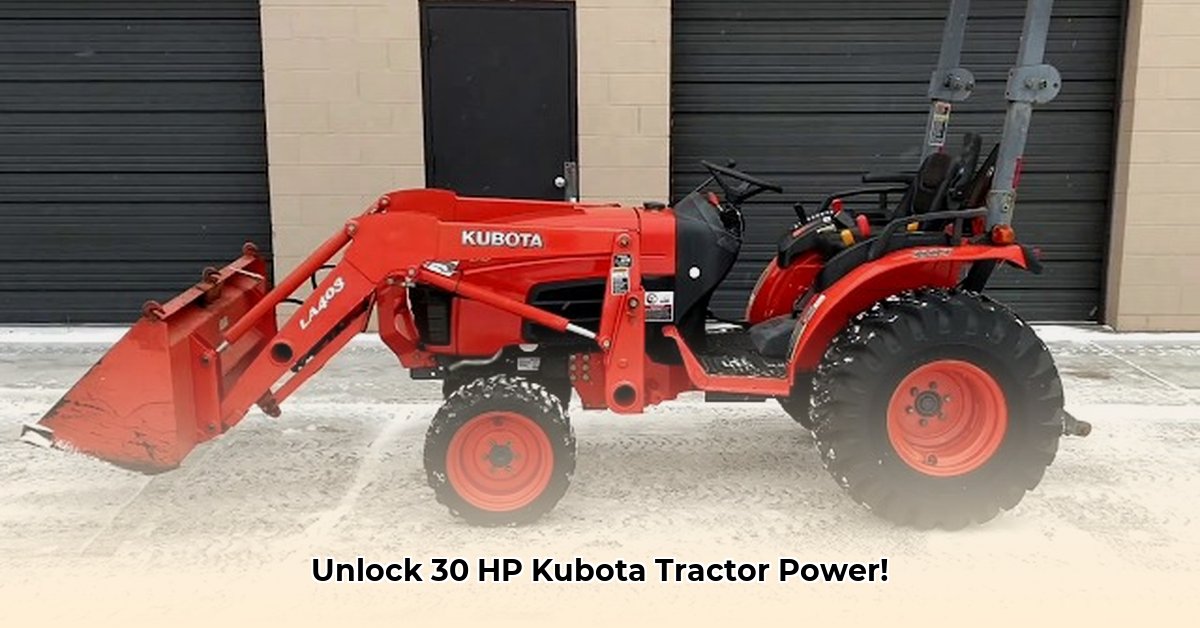
30 Horsepower Kubota Tractor: A Sustainable Farming Partner?
Considering a 30-horsepower Kubota tractor for your farm? This guide explores its suitability for sustainable agriculture, weighing the pros and cons and providing actionable steps for maximizing its benefits. We'll examine its efficiency, maintenance, and integration with sustainable practices. This isn't just about the tractor; it's about building a thriving and environmentally responsible farm. For more on Kubota attachments, check out this helpful resource: Kubota Mulchers.
The Power of Compact: Versatility for Sustainable Farms
The 30-horsepower Kubota offers a powerful yet compact design. Its smaller size minimizes soil compaction compared to larger tractors – a crucial benefit for long-term soil health and sustainability. This makes it ideal for smaller farms or those with limited space. But can its compact size deliver the power needed for various tasks? Yes. It handles a wide range of jobs, from plowing and planting to mowing and hauling, proving its versatility.
Adaptability for Sustainable Practices
This tractor's versatility shines through its compatibility with various implements. Need to till the soil? Attach a tiller. Time to mow? Swap on a mower. This adaptability streamlines operations, reducing workload and promoting efficiency – a cornerstone of sustainable farming. How can this adaptability lead to cost savings? By minimizing time spent switching equipment, it maximizes productivity and reduces downtime.
Is a 30 Horsepower Kubota Right for You? A Needs Assessment
Before investing, carefully assess your farm's needs. What farming practices do you employ? What's the terrain like (gentle slopes versus steep inclines)? The size of your fields, soil type, and even the climate influence your decision. How can I best assess my farm's needs? Conduct a thorough needs assessment, consulting with experienced farmers and agricultural experts in your region to gauge real-world experiences.
Precision Farming: Maximizing Your Investment
Combining a 30-horsepower Kubota with precision agriculture technologies unlocks significant potential. Imagine using GPS-guided implements for precise fertilizer application or planting. This targeted approach reduces waste, minimizes resource consumption (water, fertilizer), and promotes a more sustainable operation. How can precision agriculture improve profitability? It lowers input costs while minimizing environmental impact, ultimately boosting both yields and profits.
The Financial Landscape: Costs and Returns
The purchase price is just the beginning. Factor in fuel, maintenance, repairs, and insurance. Will you finance? Are leasing options preferable? Consider shared ownership with neighbors. What are the long-term financial implications? A thorough cost analysis, including long-term maintenance estimates, is essential for determining the overall return on investment.
Environmental Impact: Minimizing Your Footprint
While all machinery has an environmental impact, smaller tractors generally consume less fuel per acre worked. A 30-horsepower Kubota usually falls into this category. How can I further minimize my environmental impact? Explore alternative fuels like biodiesel, and research ongoing advancements in eco-friendly farming technologies.
A Step-by-Step Guide to Sustainable Practices
Ready to harness the full potential of your tractor for sustainable farming? Follow these steps:
- Conduct a comprehensive needs assessment: Detail your farming practices and requirements.
- Create a detailed budget: Calculate all associated costs, including maintenance and fuel.
- Select appropriate implements: Choose attachments aligned with sustainable methods (e.g., low-till implements).
- Integrate technology: Explore GPS-guided implements for precision agriculture.
- Monitor fuel consumption: Regularly track fuel usage to identify areas for improvement and potential savings.
- Research alternative fuels: Investigate the feasibility of using eco-friendly fuels.
Weighing the Pros and Cons
| Pros | Cons |
|---|---|
| Reduced soil compaction | Higher initial cost compared to smaller equipment |
| Increased efficiency in smaller fields | Fuel consumption (though generally lower than larger models) |
| Versatile with various attachments | May require more frequent maintenance for continuous use |
| Ideal for precision agriculture | Might not be suitable for extremely large farms or very steep terrains |
| Lower operating costs than larger tractors | Requires operator skill and training |
How to Choose a Compact Tractor for Sustainable Farming Practices
Key Takeaways:
- Prioritize fuel efficiency. Consider operating costs alongside the purchase price.
- Smaller tractors often minimize soil compaction.
- Precision agriculture technologies reduce resource waste.
- Local infrastructure influences fuel choices (biodiesel, electricity).
- Government incentives can lower the initial investment.
Choosing the right compact tractor is crucial. A 30-horsepower Kubota is a viable option for many, but careful consideration is key.
Assessing Your Needs: Size and Capacity
What tasks will the tractor perform? Does it handle your largest implements? Consider land size and terrain. Compactness offers maneuverability, but larger tractors might be necessary for extensive operations. This involves balancing efficiency and minimized environmental impact.
Fuel Efficiency: A Green Perspective
Fuel consumption impacts both finances and the environment. Modern diesel engines are efficient; explore alternatives like biodiesel or electric tractors, depending on your infrastructure. Long-term cost-effectiveness depends on fuel prices and maintenance. Lower fuel use translates to lower greenhouse gas emissions.
Technology and Precision Farming: Smart Investments
Modern tractors offer technologies enhancing efficiency and sustainability. GPS-guided systems enable precise application of inputs like fertilizers and pesticides thus preventing overuse and protecting the environment.
Budget and Financing: Planning for the Long Term
Account for the initial purchase price, maintenance, and fuel costs. Explore financing options and government subsidies. A well-maintained tractor extends its lifespan and improves long-term cost-effectiveness.
Maintenance and Repair: A Critical Factor
Proper maintenance prolongs the tractor's life and ensures optimal performance. Consider parts and service availability in your area. Regular servicing is an investment that reduces long-term repair costs.